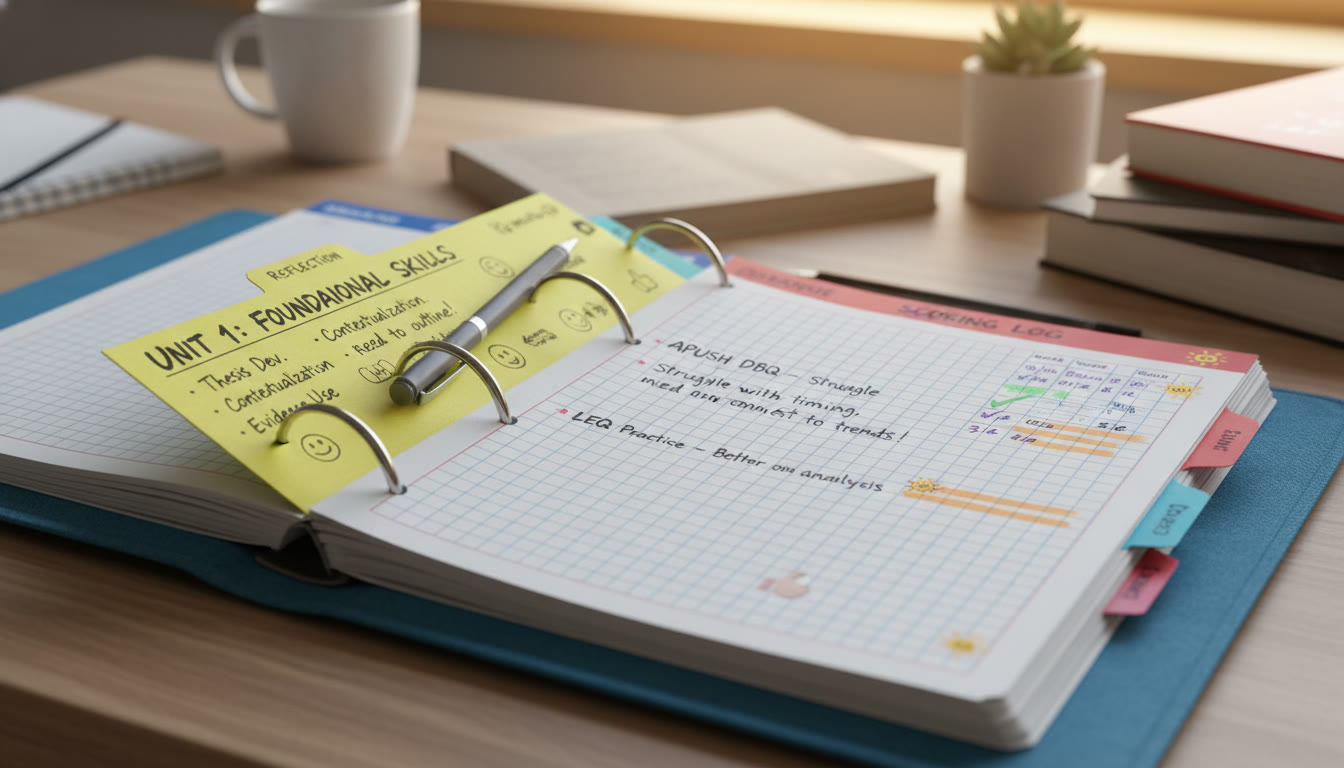Why a Dedicated FRQ Binder Changes the Game (Without You Doing the Work)
Take a deep breath. You don’t need to be an AP expert to support your student’s AP journey—especially when it comes to Free-Response Questions (FRQs). The goal isn’t to do the assignments for them; it’s to help them set up a system that makes studying smart, consistent, and calm. A well-built FRQ binder gives structure, reduces friction, and models the study habits colleges expect. Best of all, with the right approach, you can be the coach on the sidelines instead of the player on the field.

Getting the Mindset Right: Supportive, Not Solving
Before any practical steps, set a shared mindset. Say something like: “I’m here to help you set up the tools so you can practice and improve. I won’t do your work, but I’ll help you build the system to make it easier.” This frames the task as collaborative and empowers the student. It’s also a great way to model adult responsibility—parents can hold standards without micromanaging the execution.
Two simple promises to make to your student
- I will help you organize and plan, but you will complete the practice.
- I will celebrate progress, not just results.
What an FRQ Binder Actually Is
At its heart, the binder is a living study tool: a place where the student collects past FRQs, practice responses, real scored examples, feedback, and short reflection notes. It’s less about hoarding papers and more about creating a predictable workflow so practice loops (attempt, review, revise) happen quickly and deliberately.
Essential sections to include
- Index/Calendar — quick map to contents and a short practice schedule.
- Past FRQs — organized by year and prompt.
- Student Attempts — dated responses with location markers.
- Scoring and Feedback — rubrics, teacher notes, and self-checklists.
- Strategy Notes — concise tips for common pitfalls and command verbs.
- Practice Plans — short, targeted practice sessions (30–45 minutes).
- Reflection Log — one-line takeaways after each practice.
How You Can Help Build It—Without Doing the Work
The secret is to create scaffolding that the student owns. Think of yourself as the architect who draws the blueprints; the student is the builder who fills it in.
Step-by-step action plan (parent role)
- Pick a binder and supplies together — letting them choose colors and tabs increases buy-in.
- Set a single 45–60 minute kickoff session to assemble the skeleton (index, section dividers, sample FRQ).
- Provide a tidy stack of initial materials (past FRQs, rubrics, one scored example) but don’t complete entries.
- Agree on a weekly ritual — 30–45 minutes on a fixed afternoon or evening to add new practice and reflections.
- Offer tools, not answers: a highlighter for rubric calls, sticky notes for self-feedback, and a simple timer for practice sprints.
What not to do
- Don’t write their responses, summaries, or reflections for them.
- Avoid over-editing their work; focus on process and progress, not perfection.
- Don’t rescue—they need to feel the learning curve to adapt strategies.
Templates That Make the Binder Useful (and Quick)
Templates reduce decision fatigue. If your student has to decide how to format every entry, motivation drops. Create one simple set of templates and let the student tweak them.
Three must-have templates
- FRQ Attempt Sheet — prompt reference, time spent, initial answer, rubric checklist, 2-minute summary.
- Scoring Log — date, FRQ title, raw score, biggest strength, biggest improvement goal.
- Weekly Review — what worked this week, what didn’t, and three next-step actions.
Sample FRQ Binder Table: Layout and Time Investment
| Section | Contents | Initial Setup Time | Weekly Maintenance |
|---|---|---|---|
| Index/Calendar | Contents list, practice calendar | 15–20 min | 5–10 min |
| Past FRQs | Copies of questions, organized by year/topic | 20–30 min | 5–15 min (add new FRQs) |
| Student Attempts | Dated responses with attempt sheet | — (student adds) | 20–40 min (depending on practice frequency) |
| Scoring & Feedback | Rubrics, teacher comments, self-checklists | 10–15 min | 10–20 min |
| Reflection Log | One-line reflections after each session | 5 min | 5–10 min |
Designing Practice That Fits Real Life
Students are busy. The binder should fit into snatches of time and keep progress visible. The best practice plans are short, specific, and repeatable.
Three practical practice rhythms
- Short Sprint: 25–35 minutes — one FRQ prompt, timed, then quick rubric check.
- Focused Fix: 45–60 minutes — review previous attempt, rewrite a specific paragraph, apply rubric language.
- Weekly Wrap: 60–90 minutes — 2–3 timed FRQs and a reflection entry in the binder.
Encourage alternating between new prompts and revisiting older attempts. Rewriting an earlier answer with rubric language is one of the fastest ways to improve scoring skills.
How to Make Feedback Actionable (Without Taking Over)
Feedback is most useful when it’s specific and limited to one or two major improvement targets. Too many comments overwhelm students, and they stop using the notes.
A three-step feedback routine your teen can use
- Self-Score: Student uses the rubric and highlights phrases that earned points.
- One-Line Coach: You or the teacher (or a tutor) writes one sentence highlighting a strength and one sentence with a single next-step.
- Rewrite Task: Student rewrites only the part called out in the One-Line Coach step and adds a 1–2 sentence reflection in the Reflection Log.
This keeps revisions focused, reduces overwhelm, and creates measurable improvement over time.
Using the Binder for Different AP Subjects
The structure is flexible. Whether your student is in AP English, AP Biology, AP U.S. History, or AP Calculus, the same workflow applies—adjusting the rubrics and common command verbs for the subject.
Quick subject-specific notes
- English Lit/Comp — organize by theme, literary device, and sample thesis statements.
- History — keep a timeline insert and primary-source quick-reference sheet.
- Sciences — include data-interpretation checklists and formula quick-cards.
- Calculus — store solved-step templates and common problem approaches.
How Technology and Personalized Tutoring Fit In
Binders are tactile and intentional, but smart use of digital tools can make them even more powerful. For example, short video explanations or scanned rubrics can be referenced from a phone during practice. For families who want guided support, personalized tutoring can complement the binder without undermining ownership.
Sparkl’s personalized tutoring is a natural fit here: they offer 1-on-1 guidance, tailored study plans, expert tutors who can model rubric-driven responses, and AI-driven insights that point to recurring weaknesses. A tutor can help interpret teacher feedback, suggest focused rewrite tasks, and review one or two FRQs per week as part of the weekly ritual. The key is to keep the student in the driver’s seat—the tutor should coach the student to fill the binder, not do it for them.
Graduated Independence: How to Fade Your Support
Fading your involvement over time builds confidence. Start with hands-on help to set up. Then step back gradually using a predictable schedule of check-ins.
Suggested timeline
- Week 1–2: Build binder together and complete two practice entries with you nearby.
- Week 3–6: Student completes most practice; you review index and reflections once weekly.
- After Week 6: Student owns daily practice. You provide a 10-minute check-in after big practices or weekly reviews.
Measuring Progress Without Obsessing Over Scores
Points and percentiles matter, but development looks like improved clarity, faster organization of ideas, and better rubric language. Use the Scoring Log to watch trends—are raw scores nudging up? Are rewrite tasks decreasing in time? Those are the wins you want to celebrate.
Practical metrics to track
- Average score on timed FRQs over six weeks.
- Number of rewrite sessions completed.
- Speed of response — can they organize thoughts in the first 5–10 minutes?
- Student confidence — a one-line weekly mood check in the Reflection Log.
Common Pitfalls and How to Avoid Them
Even the best systems stumble. Here are predictable traps and quick antidotes.
Pitfall → Fix
- Binder becomes a paper graveyard → Schedule a monthly 20-minute purge to remove outdated or duplicate materials.
- Student treats binder as busywork → Tie practice to a short, tangible goal (e.g., rewrite to earn one rubric point in the next session).
- Parent reverts to doing the work → Use a checklist for allowed actions: set up, supply materials, encourage, and praise process.
When to Bring in Extra Help (and How to Do It Right)
If progress stalls despite consistent practice, it’s reasonable to look for targeted help. Personalized tutoring can identify pattern mistakes and accelerate growth—especially when paired with the binder workflow so feedback goes into the same organized place.
Questions to ask when choosing a tutor or program
- Will the tutor use the binder as the central place for feedback?
- Does the tutor model rubric-based responses and give rewrite tasks?
- Is there a clear plan for fading support so the student retains ownership?
Again, Sparkl’s tutoring approach emphasizes tailored study plans, expert tutors, and AI-driven insights that help pinpoint weaknesses. If you choose to combine tutoring with the binder, make sure the communication loop is tight: practice in the binder, tutor feedback goes in the binder, and the student completes the rewrites.
Celebrating Progress (Small Rituals That Work)
Progress for AP prep is incremental. Small celebrations help sustain motivation.
Simple rituals
- Sticky Note Wins — add a sticky note to the binder for every substantive improvement.
- Weekend Review Snack — a short, relaxed session where the student reads the week’s Reflections aloud and you celebrate one specific gain.
- Milestone Reward — after completing a set number of rewrites or improving average scores, celebrate with something small but meaningful: a favorite meal, a movie night, or an afternoon off.
Putting It All Together: A Sample 8‑Week Plan
Here’s a straightforward plan that turns a blank binder into a powerful study habit in two months.
Weeks 1–2: Build the Skeleton
- Kickoff session: set up dividers, templates, and three starter FRQs.
- Complete two timed FRQs together—student writes, parent times and gently encourages.
Weeks 3–6: Practice and Feedback Loop
- Weekly rhythm: two short sprints (25–35 minutes) + one focused rewrite (45 minutes).
- Add rubric-based feedback and a one-line reflection after each session.
Weeks 7–8: Consolidate and Seek Targeted Support
- Assess trends in the Scoring Log and reflections.
- If needed, bring in a tutor for 2–4 sessions to model targeted skills and leave rewrite assignments in the binder.
Final Notes: The Long View
Helping your student build an FRQ binder without doing the work for them is an act of trust. You’re investing in tools and habits that pay dividends far beyond a single exam—time management, deliberate practice, and the ability to receive and use feedback. Keep the tone positive, the steps small, and the rituals consistent. Celebrate the process and keep reminding your teen that growth is built one clear paragraph and one rubric point at a time.
If you want a little outside structure—without losing student ownership—consider a short series of tailored tutoring sessions that complement the binder and coach the student on rubric-driven rewrites. With a system in place, your teen will do the learning; you’ll just be the steady, encouraging presence helping them build the map.

Quick Checklist for the First Session
- Buy a 1–1.5 inch binder and 8 dividers.
- Print three past FRQs and one rubric.
- Create and place the three templates (Attempt Sheet, Scoring Log, Weekly Review).
- Agree on one weekly practice slot and one 10-minute weekly check-in with you.
- Make a mini celebration plan for reaching the first score improvement milestone.
Parting Thought
Parenting a student through AP season can feel like walking a tightrope between helping and hovering. The FRQ binder is a bridge: it helps students practice deliberately while giving parents a clear, limited role. You don’t have to fix everything—just help build the scaffolding that lets your student climb. That’s a powerful gift.
Want a gentle next step? Set a 45-minute weekend kickoff with your student. Bring the binder, a timer, and a sense of humor. Start small, celebrate one rewrite, and watch confidence grow.















No Comments
Leave a comment Cancel